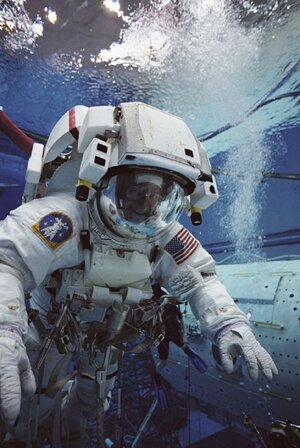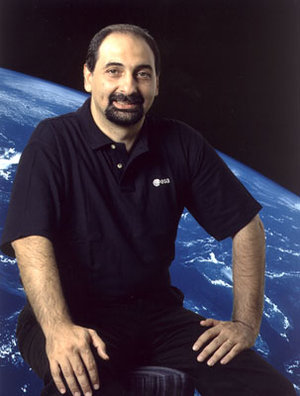Tethered Satellite System-1 Reflight USMP-3
The primary objective of STS-75 was to carry the Tethered Satellite System Reflight (TSS-1R) into orbit and to deploy it spaceward on a conducting tether.
The mission also flew the United States Microgravity Payload (USMP-3) designed to investigate materials science and condensed matter physics.
MISSION STATISTICS
Mission name: STS-75
Shuttle: Columbia
Number of crew members: 7
Launch:
22 February 1996, 20:18:00 UTC
Landing:
9 March 1996, 13:58:22 UTC, KSC, Runway 33
Duration: 15 days, 17 hours, 40 minutes, 22 seconds
Number of orbits: 251
CREW
- Andrew M. Allen (3), Commander
- Scott J. Horowitz (1), Pilot
- Jeffrey A. Hoffman (5), Mission Specialist 1
- Maurizio Cheli (1) - ESA Italy, Mission Specialist 2
- Claude Nicollier (3) - ESA Switzerland, Mission Specialist 3
- Franklin R. Chang-Diaz (5), Mission Specialist 4 and Payload Commander
- Umberto Guidoni (1) - Italy, Payload Specialist
(1) number of spaceflights each crew member has completed, including this mission

MISSION HIGHLIGHTS
Tethered Satellite System deployment
The TSS-1R mission was a reflight of TSS-1 which was flown onboard Space Shuttle Atlantis on STS-46 in July/August of 1992. The Tether Satellite System circled the Earth at an altitude of 296 kilometers, placing the tether system within the rarefied electrically charged layer of the atmosphere known as the ionosphere.
STS-75 mission scientist hoped to deploy the tether to a distance of 20.7 km (12.9 mi). Over 19 kilometers of the tether were deployed before the tether broke. It remained in orbit for a number of weeks and was easily visible from the ground, appearing something like a small but surprisingly bright fluorescent light traveling through the sky.
The specific TSS1-R mission objectives were: characterize the current-voltage response of the TSS-orbiter system, characterize the satellites high-voltage sheath structure and current collection process, demonstrate electric power generation, verify tether control laws and basic tether dynamics, demonstrate the effect of neutral gas on the plasma sheath and current collection, characterize the TSS radio frequency and plasma wave emissions and characterize the TSS dynamic-electrodynamic coupling.
TSS-1R Science Investigations included: TSS Deployer Core Equipment and Satellite Core Equipment (DCORE/SCORE), Research on Orbital Plasma Electrodynamics (ROPE), Research on Electrodynamic Tether Effects (RETE), Magnetic Field Experiment for TSS Missions (TEMAG), Shuttle Electrodynamic Tether System (SETS), Shuttle Potential and Return Electron Experiment (SPREE), Tether Optical Phenomena Experiment (TOP), Investigation of Electromagnetic Emissions by the Electrodynamic Tether (EMET), Observations at the Earth's Surface of Electromagnetic Emissions by TSS (OESSE), Investigation and Measurement of Dynamic Noise in the TSS (IMDN), Theoretical and Experimental Investigation of TSS Dynamics (TEID) and the Theory and Modeling in Support of Tethered Satellite Applications (TMST).
The USMP-3 payload consisted of four major experiments mounted on two Mission Peculiar Experiment Support Structures (MPESS) and three Shuttle Mid-deck experiments. The experiments were: Advanced Automated Directional Solidification Furnace (AADSF), Material pour l'Etude des Phenomenes Interessant la Solidification sur Terre et en Orbite (MEPHISTO), Space Acceleration Measurement System (SAMS), Orbital Acceleration Research Experiment (OARE), Critical Fluid Light Scattering Experiment (ZENO) and Isothermal Dendritic Growth Experiment (IDGE).
Trivia
STS-75 also was the first use of Linux operating system on orbit. An older Digital Unix program, originally on DEC Alpha servers, was ported to run on Linux on a laptop. The next use of Linux was a year later, on STS-83.
In addition many video tapes of the broken tether have apparent UFO sightings in them. These supposed 'sightings' have been dismissed by NASA as dust bunnies and other space junk.
STS-75 was the shuttle mission described in the fictional NASA Document 12-571-3570, written by astronomer and scientific writer Pierre Kohler. This hoax document reports of experiments to determine effective sexual positions in zero gravity. Although the document describes heterosexual sex, all crew members aboard STS-75 were male.















 Germany
Germany
 Austria
Austria
 Belgium
Belgium
 Denmark
Denmark
 Spain
Spain
 Estonia
Estonia
 Finland
Finland
 France
France
 Greece
Greece
 Hungary
Hungary
 Ireland
Ireland
 Italy
Italy
 Luxembourg
Luxembourg
 Norway
Norway
 The Netherlands
The Netherlands
 Poland
Poland
 Portugal
Portugal
 Czechia
Czechia
 Romania
Romania
 United Kingdom
United Kingdom
 Slovenia
Slovenia
 Sweden
Sweden
 Switzerland
Switzerland





























